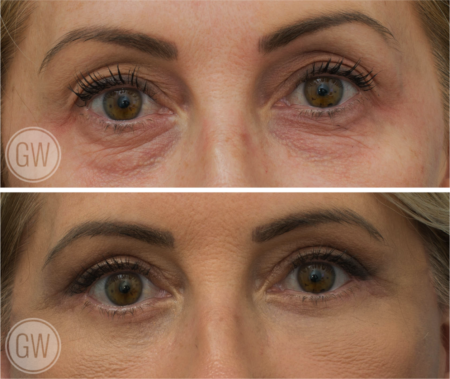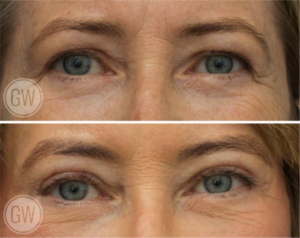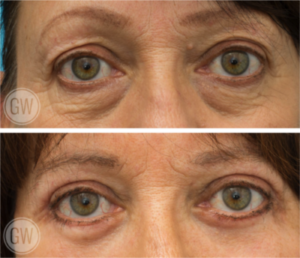
14 May What are Hooded Upper Eyelids? – Causes & Solutions
Understanding the Causes and Treatment for Hooded Eyelids
Are you tired of constantly feeling self-conscious about your hooded upper eyelids? Do you find yourself avoiding certain makeup looks or feeling like you look tired even when you’re well-rested? Well, you should know that you’re not alone. Hooded upper eyelids are a common cosmetic concern for many people, and they can be caused by a variety of factors. But the good news is that there are effective remedies that can help you say goodbye to hooded upper eyelids for good. In this blog, we’ll explore the most common causes of hooded upper eyelids and share some of the best remedies to help you achieve a more refreshed appearance. From simple lifestyle changes to more advanced cosmetic procedures, we’ll cover everything you need to know.
Perth Specialist Plastic Surgeon Dr Guy Watts provides a comprehensive approach to addressing hooded eyes, helping patients achieve a more refreshed appearance. Through personalised consultations, he carefully assesses each patient’s unique needs and concerns before recommending the most suitable treatment option, whether it be non-surgical interventions or surgical procedures such as blepharoplasty. By utilising advanced techniques and prioritising patient safety, Dr Guy Watts ensures optimal results that enhance his patients’ natural beauty while respecting their individual aesthetic goals.
Causes of Hooded Upper Eyelids
Understanding the anatomy of the eye is essential to know what causes hooded upper eyelids. The eyelids are composed of thin skin and a layer of muscle that lifts and lowers the eyelid. The skin on our eyelids is the thinnest on our body and is prone to sagging due to ageing, sun damage, and other factors. Hooded upper eyelids occur when the skin on the upper eyelid droops, making the eyelid appear smaller and less defined. There are several factors that can contribute to hooded upper eyelids, including the following:
Ageing
Ageing is the primary cause of hooded upper eyelids. As we age, our skin loses elasticity and firmness, making it more prone to sagging. This loss of elasticity is particularly evident in the delicate skin around the eyes. The muscles that support the eyelids also weaken with age, further contributing to the drooping effect. The combination of these factors can result in significant hooding of the upper eyelids, making the eyes appear smaller.
Genetics
Genetics also play a role in the development of hooded upper eyelids. If your parents or other family members have hooded upper eyelids, you may be more likely to develop them as well. This is because the shape of our eyes and the thickness of our skin are largely determined by our genes. While we can’t change our genetics, there are still steps we can take to minimise the appearance of hooded upper eyelids.
Lifestyle factors
Lifestyle factors such as sun exposure, smoking, excessive use of alcohol, and poor nutrition can also contribute to the development of hooded upper eyelids. Sun damage can cause the skin to lose elasticity and firmness, while smoking can accelerate the ageing process and contribute to sagging skin. A diet lacking in essential nutrients can also affect the skin’s health and contribute to premature ageing.
Non-Surgical Remedies for Hooded Upper Eyelids
If you’re looking for non-surgical remedies for hooded upper eyelids, there are several options available. These remedies can help reduce the appearance of hooding and give your eyes a more refreshed look. Here are some of the most effective non-surgical remedies for hooded upper eyelids:
Eye creams
Eye creams are a popular non-surgical remedy for hooded upper eyelids. Look for eye creams that contain ingredients like retinol, vitamin C, and caffeine, which can help firm and tighten the skin around the eyes. These ingredients can also help reduce the appearance of fine lines and wrinkles, giving the eyes a more refreshed look.
Anti-wrinkle injections
Anti-wrinkle injections are a popular cosmetic treatment that can help reduce the appearance of hooded upper eyelids. Anti-wrinkle substances work by relaxing the muscles that cause the eyelids to droop, giving the eyes a more lifted and refreshed appearance. The effects of anti-wrinkle injections usually last for several months, making it a popular choice for those who want a non-surgical solution to hooded upper eyelids.
Laser resurfacing
Laser resurfacing is a non-invasive surgical option for hooded upper eyelids. This procedure involves using a laser to remove the top layer of skin on the eyelids, promoting the growth of new, healthy skin. Laser resurfacing can help tighten and firm the skin around the eyes, giving them a more refreshed appearance.
Eyelid fillers
Eyelid fillers are a non-surgical treatment option that can provide a temporary solution for individuals seeking to correct hooded eyes. This minimally invasive procedure involves injecting dermal fillers, such as hyaluronic acid, into targeted areas around the eyelids to add volume and support to the skin. By carefully placing the filler, a skilled practitioner may be able to create a subtle lift to the upper eyelid, reducing the appearance of hooding and restoring a more rejuvenated look. Although the results are not as long-lasting as surgical interventions like blepharoplasty, eyelid fillers can be an effective option for those who prefer a less invasive approach with minimal downtime.
Surgical Options for Hooded Upper Eyelids
If non-surgical remedies aren’t providing the results you’re looking for, there are several surgical options available for hooded upper eyelids. These procedures can help lift and tighten the skin around the eyes, giving you a more refreshed appearance. Here are some of the most common surgical options for hooded upper eyelids:
Blepharoplasty
Blepharoplasty, also known as eyelid surgery, is a popular surgical treatment for hooded upper eyelids. This procedure involves removing excess skin and fat from the eyelids, giving the eyes a more lifted and defined appearance. Upper Lid Blepharoplasty may be performed under local or general anaesthesia and Lower Lid Blepharoplasty is be performed under general anaesthetic.
Brow lift
A brow lift is another surgical option for hooded upper eyelids. This procedure involves lifting and tightening the skin and muscles of the forehead, which can help elevate the eyebrows and reduce the appearance of hooded upper eyelids. Brow lifts are performed under general anaesthesia and can be done using a variety of techniques, including endoscopic and open brow lifts.
Recovery and Aftercare for Eyelid Surgery
If you decide to undergo eyelid surgery or any other surgical treatment for hooded upper eyelids, it’s important to understand the recovery and aftercare process. You’ll likely experience some swelling and bruising after surgery, which can take several weeks to fully subside. It’s important to follow your surgeon’s instructions for aftercare, which may include using cold compresses, keeping your head elevated, and avoiding strenuous activity for several weeks.
Prevention Tips for Hooded Upper Eyelids
Prevention is always the best course of action when it comes to hooded upper eyelids. While some factors, such as genetics, are out of our control, there are still steps you can take to minimise the appearance of hooding. Here are some tips for preventing hooded upper eyelids:
- Protect your skin from the sun: Sun damage is a major contributor to premature ageing and sagging skin. Protect your skin from the sun by wearing sunscreen and avoiding prolonged sun exposure, especially during peak hours
- Quit smoking: Smoking accelerates the ageing process and contributes to sagging skin. Quitting smoking can have a significant impact on the health and appearance of your skin, including the fine skin around your eyes
- Eat a healthy diet: A diet rich in essential nutrients can help keep your skin looking healthy and youthful. Focus on eating plenty of fruits, vegetables, whole grains, and lean protein to support the health of your skin
- Avoid excessive consumption of Alcohol: Excess Alcohol can cause fluid retention and puffiness around the eyes which results in stretching to the tissue
Hooded upper eyelids can be a frustrating cosmetic concern, but there are effective remedies available. Remember to take steps to prevent the development of hooded upper eyelids, such as protecting your skin from the sun and maintaining a healthy lifestyle. With the right approach, you may be able to say goodbye to hooded upper eyelids for good.
FAQs about Causes and Solutions for Hooded Upper Eyelids
How do you fix hooded upper eyelids?
- There are a few ways to address hooded upper eyelids, ranging from cosmetic treatments to surgical procedures. Non-surgical treatments may include chemical peels, laser resurfacing, or dermal fillers to rejuvenate and tighten the skin around the eyes. Blepharoplasty is a surgical procedure that involves removing excess skin, muscle, and/or fat from the upper eyelids to create a more youthful appearance.
What causes upper eyelid hooding?
- Upper eyelid hooding can be caused by several factors such as ageing, genetics and lifestyle. As people age, skin loses elasticity and muscles around the eyes weaken, which can lead to drooping or sagging eyelids. Some people are genetically predisposed to have hooded eyelids. Prolonged sun exposure, smoking, and poor diet can contribute to skin ageing and eyelid hooding.
Can you reverse hooded eyelids?
- Depending on the severity and cause of hooded eyelids, certain treatments may help reverse or improve the appearance of hooding. Non-surgical treatments like chemical peels or laser resurfacing can provide temporary improvement, while surgical options like blepharoplasty can provide more long-lasting results.
How can I reduce my hooded eyelids naturally?
- While it’s difficult to reverse or reduce hooded eyelids completely through natural means, there are some steps you can take to help maintain the health of your skin and potentially minimise the appearance of hooding:
- Proper skincare: Maintain a consistent skincare routine that includes cleansing, moisturising, and using sunscreen to protect your skin from sun damage
- Healthy diet and hydration: Consuming a balanced diet rich in vitamins, antioxidants, and essential fatty acids can help support skin health. Minimising alcohol consumption and staying hydrated can also help maintain skin elasticity
- Eye exercises: Some people believe that eye exercises can help strengthen the muscles around the eyes and improve the appearance of hooded eyelids, although scientific evidence for this is limited
- Sleep: Ensure you get enough sleep each night, as lack of sleep can contribute to skin ageing
Do hooded eyes get worse with age?
- Yes, hooded eyes tend to get worse with age. The skin around the eyes is one of the first areas to show signs of ageing due to a loss of elasticity. Older individuals who naturally have hooded eyes may experience more significant effects of ageing because their eyes are already surrounded by more skin.
Further Reading about Face Surgery with Dr Guy Watts
- Read Dr Guy Watts’ Face and Neck Lift Page
- Read Dr Guy Watts’ Brow Lift Page
- Read Dr Guy Watts’ Blepharoplasty Page
- Read Dr Guy Watts’ Facial Augmentation Page
- Read Dr Guy Watts’ Rhinoplasty Page
Medical References about Hooded Eyelids
Dr. Guy Watts – Specialist Plastic Surgeon In Perth WA
Dr. Guy Watts (AHPRA Medical Reg. MED0001539378) is a Specialist Plastic Surgeon with an extensive career that spans across renowned plastic surgery clinics worldwide. His exceptional expertise has been honed through invaluable experiences at esteemed establishments such as the prestigious New York Eye and Ear Infirmary and the renowned Pitanguy Clinic in Brazil.
Having collaborated with the foremost cosmetic plastic surgeons on a global scale, Dr. Watts has chosen to return to Perth after a remarkable 17-year journey of intensive training and invaluable professional experience to bring the latest practices and technology in cosmetic plastic surgery to his patients.
Dr. Watts is a Fellow of the Royal College of Surgeons (FRACS) and a Member of the Australian Society of Plastic Surgeons (ASPS), Australasian Society of Aesthetic Plastic Surgeons (ASAPS) and the International Society of Aesthetic Plastic Surgeons (ISAPS).










